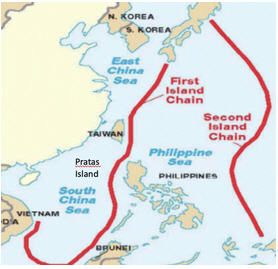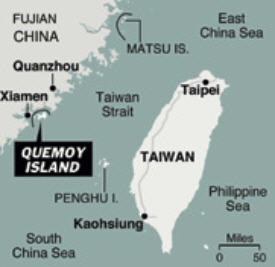The First Island Chain

Times being what they are, we were thinking about Formosa. That leads to part of the confusion. That large island is now known as “Taiwan,” and reflects some of the who-and-where parts of China’s rise. We are in the process of having another Formosa crisis with some new names. We do that periodically. When many of the Writer’s Section were young, two small places achieved notoriety as the flash points for global catastrophe. They were islands known as “Quemoy” and “Matsu,” and represented small garrisons of Chiang Kai Chek’s Nationalist government just off the mainland. They were part of the noise of that decade that emanated from our little transistor radios. If you look on a map, you can see how they became flashpoints:

There were two major international hoo-raws back then, rockets fired and escalating tensions that had the potential to do what Marlow talked about yesterday: go nuclear. It was part of establishing the balance of Cold War political and military balance. In 1955 and again in 1958, China and the United States came dangerously close to active combat over control of Quemoy and Matsu, two small islands just off the coast of the mainland PRC. The first crisis caused the Eisenhower Administration to threaten use of weapons of mass destruction, since it considered surrender of any Taiwanese territory could cause the collapse of Chiang’s regime. The second crisis in 1958 was more deadly. A PRC attempt to seize the small island of Dongding was repulsed, which triggered a massive PLA artillery response that killed over 500 Taiwanese soldiers. In the end, the Taiwanese prevailed with the use of American-provided jet aircraft against Russian-provided PRC Migs. Having come close enough to the brink that grade school kids in my home town were practicing “duck and cover,” Taiwan and China settled into a desultory pattern of bombarding one another on alternate days of the week, a semi-civilized practice that continued into the 1970s.
Now, tensions are ramping up again. Instead of Quemoy and Matsu, the PRC is simulating attacks on other islands. The Pratas/Dongsha, your pick, Islands are parts of an atoll in the South China Sea to the south and west of Formosa. According to reports from the area, Chinese naval forces conducted a war game that featured the seizure of Pratas and surrender of the Nationalist 500 man garrison. A glance at what the PRC has claimed as their territorial sea-boundaries above is useful to understand things.
Your correspondents are a little apprehensive about what the PRC is up to these days. The hundredth anniversary of the Chinese Communist Party is in progress. The Olympics are supposed to be held there next year, and participation is becoming an issue based on the PRC’s continuing operations inside Taiwan’s “Air Defense Identification Zone (ADIZ).” The American government, with respect due to all the officials specifically mentioned in the Uniform Code of Military Justice, are making decisions about the situation best known only to themselves.
We have been through this before, and the Writer’s Circle includes a small group that remembers the words “Quemoy” and “Matsu.”
They have not been identified as potential flash points in a struggle a long way across the vast Pacific. Here is where it started. In 1949 the Communists under Mao Tse-tung were consolidating their grip on the mainland. Deposed president Chiang Kai-shek led a million of his followers to Formosa. The only thing he and Mao had in common was their insistence that Taiwan remained part of China. The Nationalist-held islands of Jinmen, known to us as Quemoy and Mazu, known to us as Matsu, were just eight miles off the coast of mainland China, between Formosa and mainland China, were occupied by Chiang’s forces but claimed by the Chinese Communists. Matsu is a single island, while Quemoy is a group consisting of Quemoy, Little Quemoy, and 12 islets in Xiamen Bay.
Chiang fortified these two islands as bases for his re-conquest of China. Chiang provoked China on two occasions by moving large numbers of troops to the islands, and both times the US responded with military actions, including nuclear threats, in support of Chiang’s provocations.
On 05 January 1950 President Harry Truman announced that “the United States will not involve in the dispute of Taiwan Strait,” which meant America would not intervene if the Chinese communists were to attack Taiwan. Six months later, the Korean War broke out. President Truman reacted by declaring the “neutralization of the Straits of Formosa” on June 27. The Seventh Fleet was sent into the Straits under orders to prevent any attack on the island, and also prevent the Kuomintang (KMT) forces to attack on China. From that point on, Taiwan was placed under a state of ambiguous US military protection. Or at least the places that had names we could follow.
Screen Shot 2021-11-14 at 8.24.52 AM.png
(Hotel Roma, Taipei, Taiwan).
The last time we were there was fun. I had managed to stop thinking about it as “Formosa,” and arranged a trip for our favorite Congressman. He told me what he wanted to do and who he wanted to see. It was going to be my last major trip to arrange while assigned to the Navy’s Office of Legislative Affairs, a chaotic and fun job. This one included a list of places around what the Chinese later would call “The First Island Chain.”
That included Taipei, Hong Kong, Rangoon, Beijing, Shanghai, Pyongyang and Seoul. All the places had their issues. While a quarter century has changed some of the names and some of the issues, the First Island Chain has demonstrated where their interests are located. You will notice that all of them- Burma, Quemoy, Matsu, Pratas and Taiwan are all inside.
EVA Airlines, national carrier of Taiwan, was comfortable with their name. On arrival in Formosa, the flight crew gave us all strange jewelry boxes containing small glass cows with golden heads. Odd things, and mine is on a shelf here at The Farm somewhere. After a brief ceremony with the flight crew, we met an American named Chris Lafleur and a section chief from Taiwan’s Department of North American Affairs named Donald C.O. Lee in a private suite at Chiang Kai-shek International. The two gentlemen were careful with place names and gave us a perspective on cross-straits politics and where the issues were at that particular moment, regardless of their names.
The biggest deal was the PRC’s concern that the Taiwanese would declare that there was no “One China,” setting the stage for a war of independence, but things were fairly relaxed at that moment, since the mainland wanted to ensure that Hong Kong’s reversion from Britain to Chinese control stayed on track. That is part of the fun with the PRC, since the issues are many and the time is always short.
Later, a bit bleary, we went to the hotel coffee shop and met Mimi Myint-hui, a first-generation Burmese woman whose family owned the Mingala West Restaurant on Amsterdam Avenue in New York. She was connected to the network of overseas Burmese who were committed to the overthrow of the SLORC, and the release of The Lady, Nobel Laureate Aung San Suu Kyi. Thankfully, I only had the bag-and-drag part of the portfolio, not the issues for each of the countries we were going to visit. I could never forget that the Congressman had an agenda to work in all these places, but that was his issue and not mine. I was just responsible for ensuring the cars drove and the airplanes flew to the right places, the names of the moment being critical in that regard.
The Communists and Nationalists had stopped shelling each other’s islands years before. But when we visited that time, things were changing. And they have changed again. Where the situation is going in what used to be Burma and Formosa is a matter you can easily determine by looking at the First Island Chain. We will have to get to that another time, though, since we spent this morning determining what places we were talking about. Along with the matter of Danny Fenster, a Detroiter by birth. We have talked about him before. He is a journalist who has been under detention by the current Junta since his arrest last May. On Friday, a military court sentenced him to 11 years in prison for speaking his mind. That is not permitted in Myanmar these days. He is 37 now, and will be 48 before he is free again.
But there may be some changes. This morning, the Writer’s Section was looking for Mimi, in hopes she could help us formulate a decent plan to get him released. So, we expect some additional things could change, even inside the 1st Island Chain. We will be working on it.
Copyright 2021 Vic Socotra
www.vicsocotra.com
